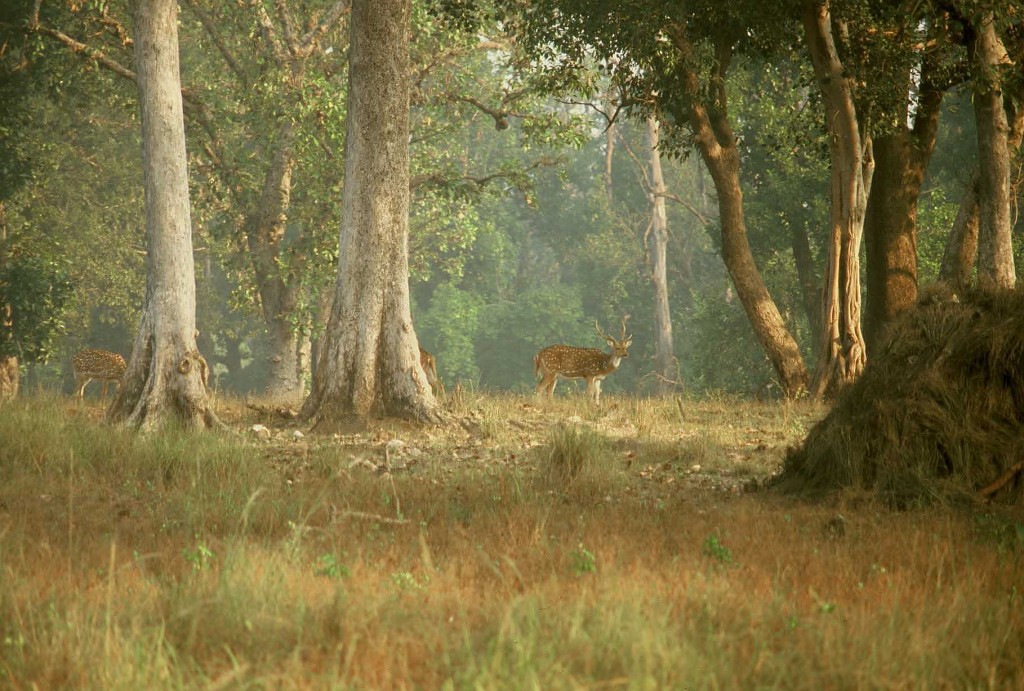We arrived at Kanha National Park in our jeeps, accompanied by a sharp-eyed guide, ready to discover the secrets of the forest. Like everyone on the trip to Kanha National Park, we were looking for Sher Khan, the big cat who Rudyard Kipling so lovingly vilified and immortalised at the same time in his Jungle Book. We were tracking the tiger, by following pugmarks, keeping our eyes peeled for signs of dragged kill and listening for alarm calls. In spite of all that, the majestic animal just wouldn’t oblige us with its presence. The next day, we went along for what is sometimes derisively called the ‘tiger show’, an orchestrated encounter with the cat. This is when the mahouts drive their herd of ‘tracker’ elephants into the forest and use a sophisticated radio system to communicate the movements of the tiger — all of this happens while you sip coffee at the visitor centre and wait for your turn to clamber on to an elephant at Kanha National Park.
A royal sight
As expected, our first sighting of the tiger was atop an elephant — the striped animal had just hunted, and, as was clear from a carcass, made a meal of a big cheetal. He was so desperate to rest that he lifted his head just twice even when three elephants hovered above him. The fact that this sighting was stage-managed, surprisingly, didn’t take away the thrill of spotting a tiger in his lair. After this encounter, we hopped back into our jeeps and drove off towards a direction where, we were told, we would be able to spot wild dogs. Slim, red and bushy-tailed, wild dogs or dholes are the most feared savages in the jungle. We spotted half a dozen dholes, which had just finished taking down, and eating, three cheetal.
They were roving through the grasses close to Shravantal, a beautiful water body where the chances for sighting birds are very high. There were more stunning views in store. In the evening, we enjoyed a picturesque drive to Bamhanidadar, the highest motorable point in the Park at 2,865ft, once used as an airstrip for hunting parties. By the road, the forests changed from sal and bamboo to mixed trees, the soil became loamier and the hills reflected the mood of the skies. One should never miss taking the jeep safari when here. Never!!
At the Sunset Point at Bahmnidadar, we were once again rewarded with a spectacular view of the entire Banjar River Valley. Perhaps the best part of our trip was when, during our drive around the forest, a swarm of antlers belonging to a company of barasingha emerged out of tall grass. Just over three decades ago, the barasingha population in the Park had gone down considerably and the species was close to extinction. Thanks to conservation efforts, their numbers have now risen. As the deer shook their antlers, it seemed as if they were telling us their success story. It’s one tale that we would always be glad to hear, again and again.
The Park
Kanha National Park is 2,000 sq km in size. It occupies a horseshoe- shaped valley and grasslands surrounded by the Satpura mountains, at heights ranging between 1,500ft and 3,000ft. Comprising the Banjar and Halon valleys of the erstwhile princely provinces of Central India, this area became a hunting ground for the British from 1879-1910. In 1933, Kanha was established as a sanctuary. It was declared a National Park in 1955. The Park plays host to a rare species of barasingha — swamp deer — which live in a hardground habitat. It’s believed that the name Kanha was derived from the texture of the soil found in this area. The soil is sandy in Banjar Valley in the Kanha, Kisli and Mukki ranges. In the lower pockets, the soil is finely textured and tends to be somewhat clayey. It is locally called kanhar, and this apparently gave the National Park its name. Though it is one of India’s better-protected Project Tiger reserves, conservationists do have their worries about Kanha. This is due to its proximity to impoverished villages, and its closeness to Nagpur, which is known as an illegal wildlife trade hub in Central India.
Now it’s time for some factoids
Location
Kanha and its Maikal Range, part of the Satpura Range, carves itself on to the eastern profile of Madhya Pradesh.
Distances
242 km NE of Nagpur, 489 km SE of Bhopal Route from Delhi NH2 to Agra; NH3 to Biaora; NH12 to Jabalpur via Bhopal; NH12A to Mandla; district roads to Kanha (Kisli) via Bamhni. To know the exact distances and the means to reach from any point, explore ixigo’s Trip Planner .
Route from Nagpur
NH6 to Bhandara; state roads to Kanha (Mukki) via Balaghat and Baihar.
By Kshitiz





